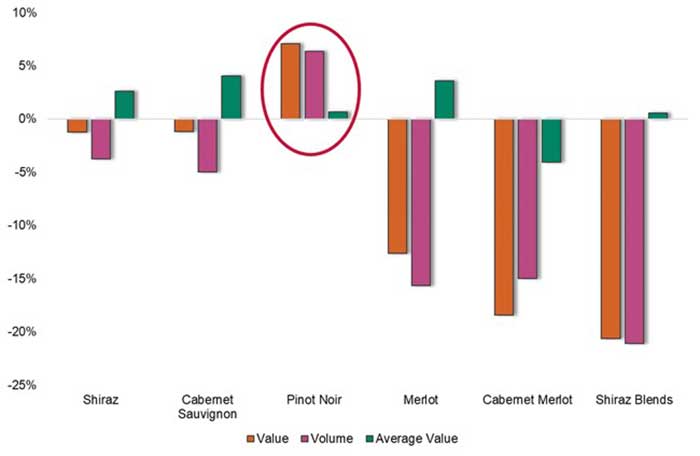Ahead of the Pinot Noir Celebration on 10 and 11 February 2023, this Market Bulletin provides an overview of the current state of play for Australian Pinot Noir. For more detail, a PDF version of these insights is available to download here.
Average purchase price of Pinot Noir is rising
Pinot Noir is the fourth largest red variety grown in Australia, with a 5 per cent volume share. Australia’s Pinot Noir crush in 2022 was 44,271 tonnes, 19 per cent down from the 2021 record-sized crop and 9 per cent below the 5-year average.
The inland regions of Riverland, Murray Darling–Swan Hill and Riverina make up three out of the four largest producing regions of Pinot Noir. Together, the Pinot Noir crush of these three regions has grown by nearly 30 per cent since 2020. Outside of the inland regions, Tasmania, Adelaide Hills, and Yarra Valley produce the most Pinot Noir.
The average price of Pinot Noir in 2022 was $1,200 per tonne across all of Australia. The average price increased in both warm inland regions (up 6 per cent to $682 per tonne) and cooler/temperate regions (up 10 per cent to $2,171). In the past 10 years the average price of Pinot Noir has risen steadily, at an average of 5 per cent per year. Pinot Noir has the second highest average price per tonne of the top 10 reds in the cool/temperate regions, second only to Grenache ($2,201/tonne).
Pinot Noir outpaces other red varieties in off-trade growth
The sales volume and value of most of the top red varieties in the Australian off-trade channel declined in 2022. However, sales of Pinot Noir increased by 7 per cent in value and 6 per cent in volume. The largest share of Pinot Noir sales in the Australian off-trade sits in the $20–29.99 segment, with a 31 per cent volume share.
Figure 1 Year-on-year change in off-trade volume, value, and average value, MAT July 2022

Source:IRI MarketEdge
For Australian Pinot Noir, Tasmania holds the highest share of value in the off-trade at 22 per cent, although this has declined over the past two years. Yarra Valley, South Eastern Australia, and South Australia have also declined in share. Meanwhile, gaining share of off-trade value are Adelaide Hills (8 per cent share), and Barossa Valley (3 per cent share).
Pinot Noir is the top listed red variety in the Australian on-trade
In the Australian on-trade, Pinot Noir has the most listings of red wine varieties on wine lists in bars and restaurants, with an 18.5 per cent share. However, this was down from a 19.3 per cent share in 2021.
Figure 2 - Share of red wine on-trade listings by variety

Source: Wine Business Solutions
Tasmania (16 per cent share), Mornington Peninsula (10 per cent), and Geelong (4 per cent) all increased their share of Pinot Noir on-trade listings in 2022, compared to 2021. Meanwhile, Gippsland, Adelaide Hills, and Yarra Valley declined in share. Tasmania overtook Yarra Valley as the top regional Pinot Noir listing in 2022.
Exports of Pinot Noir growing since 2020
In the 2021–22 financial year, exports of Pinot Noir grew by 6 per cent in volume to 6.9 million litres and 6 per cent in value to $36 million. In the past decade, the volume of Australian Pinot Noir exports has declined by an average of 1 per cent per annum, meanwhile value has grown by an average of 1 per cent per annum. The decline in volume but increase in value of the last decade has combined to increase average value by 2 per cent per annum, from $4.16 per litre in 2011–12 to $5.18 in 2021–22.
Figure 3 - Volume and value of Pinot Noir exports over time (year ending June)

Source: Wine Australia
In general, most (about 80 per cent) exported Pinot Noir is in the still red wine style. Sparkling/carbonated Pinot Noir used to have a much larger share of exports (27 per cent in 2009–10) but has now fallen to 17 per cent in 2021–22. In recent years, Pinot Noir rosé exports have increased, although off a small base. In 2009–10, they were less than 1 per cent of Pinot Noir exports, and in 2021–22 that share has risen to 2 per cent.
The United States of America is by far the largest market for Australian Pinot Noir exports[1] , growing by 13 per cent to $13 million in 2021–22. Several markets have grown in the past 12 months – including Japan, Singapore, Sweden, and Canada.
Figure 4 - Top 10 destination markets by value of Pinot Noir exports, MAT June

Source: Wine Australia
As with total Australian exports, the GI of ‘South Eastern Australia’ makes up the majority of Pinot Noir exports that have a GI identified. Yarra Valley, Tasmania, Adelaide Hills, and Gippsland follow behind. In the past three years, Yarra Valley exports have declined, Tasmania and Adelaide Hills have been stable, while Gippsland exports have increased.
To find out more about Pinot Noir
The Pinot Noir Celebration Australia is a two-day celebration that will investigate the changing influences on the world of Pinot Noir and imagine the future; exploring technique, expression of site and landscape, custodianship and innovation. More than 150 Pinot Noir wines from across Australia and around the world will be poured over the two days. For further details and to purchase tickets before the 3 February 2023 deadline: https://www.pinotcelebration.com.au/
---
[1] All exports statistics from this point onwards refer to only still red exports of Pinot Noir.
